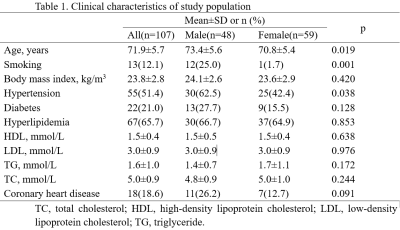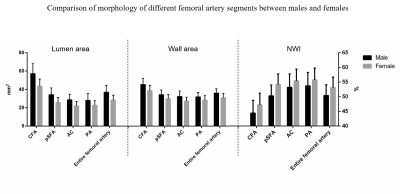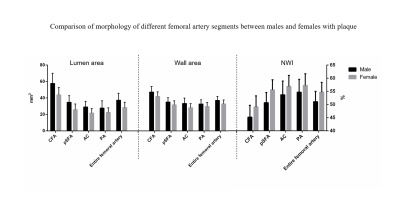1625
Comparison of femoral artery plaque characteristics between men and women in elderly population using magnetic resonance vessel wall imaging11Medical School of Chinese PLA, Beijing, China., Beijing, China, 2Department of Radiology, the Fifth Medical Center, Chinese PLA General Hospital, Beijing, China., Beijing, China, 3Department of radiology, Aerospace Center Hospital, Beijing, China., Beijing, China, 4Department of Radiology, The Affiliated Hospital of Yangzhou University, Yangzhou University, Yangzhou, China, Yangzhou, China, 5Department of Radiology, the Fifth Medical Center, Chinese PLA General Hospital, Beijing, China., Beijing, China, Beijing, China, 6Center For Biomedical Imaging Research, Department of Biomedical Engineering, School of Medicine, Tsinghua University, Beijing, China, Beijing, China
Synopsis
We sought to investigate the differences of plaque characteristics in different femoral artery segments between males and females using magnetic resonance vessel wall imaging. The 3D-MERGE was acquired from the common femoral artery to the popliteal artery. We compared the differences of femoral artery plaque characteristics between men and women. Men had significantly larger area of lumen and wall, but smaller normalized wall index compared with women. Men have larger vessel size but lower plaque burden then women, more attention is needed to be paid to asymptomatic elderly women.
Introduction
Lower extremity peripheral artery disease (LE-PAD) has become a significant health burden especially in the elderly population all around the world[1]. The aim of this study was to investigate the differences of atherosclerotic plaque characteristics in different femoral artery segments between male and female subjects in asymptomatic elderly adults using cardiovascular magnetic resonance (CMR) vessel wall imaging.Methods
Elderly asymptomatic subjects were recruited and underwent three-dimensional (3D) CMR vessel wall imaging for femoral arteries. The 3D motion sensitized-driven equilibrium prepared rapid gradient-echo (3D-MERGE) was acquired from the common femoral artery to the popliteal artery. Clinical characteristics including age, body mass index (BMI), history of smoking, hypertension, diabetes, hyperlipidemia and coronary heart disease were collected from clinical record. We divided femoral artery into 4 segments: common femoral artery (CFA), proximal superficial femoral artery (pSFA), adductor canal (AC), and popliteal artery (PA). The presence of atherosclerosis plaque was determined and the morphology characteristics of each segment were measured including lumen area, wall area, normalized wall index (NWI = wall area/[lumen area+wall area]×100%), maximum and minimum wall thickness, eccentricity index ([maximum wall thickness–minimum wall thickness]/maximum wall thickness), and luminal stenosis. After that, the parameters above were compared between all male and female subjects, then between male and female subjects with atherosclerotic plaque using independent t test, Mann-Whitney U test, or Chi-square test as appropriate. Next, we adjusted for the parameters which were significantly different (p<0.05) between male and female subjects for clinical confounding factors whose p<0.1 in the comparison between male and female subjects using multiple liner or logistic regression models.Results
Of 107 eldely subjects (mean age: 71.9±5.7 years old), 48 are males (73.4±5.6 years old) and 59 area females (70.8±5.4 years old). Table 1 showed clinical characteristics of this study population. In all 107 subjects, after adjusted for clinical risk factors including age, hypertension and coronary heart disease (smoking was excluded because of its small sample size), men had larger lumen area in CFA, pSFA, AC, PA and entire femoral artery, wall area in CFA, pSFA, AC, PA and entire femoral artery, thicker maximum wall thickness than female subjects in AC, but smaller NWI in CFA , pSFA, AC, PA and entire femoral artery (all p<0.05, Figure 2) compared with women. In subjects with atherosclerotic plaque, after adjusted for the same confounding factors above, men had larger lumen area in CFA , pSFA, AC, PA and entire femoral artery, wall area in CFA, pSFA, AC, PA and entire femoral artery, but smaller NWI in CFA , pSFA, AC, PA and entire femoral artery (all p<0.05, Figure 3) compared with women.Discussion
The two primary risk factors for the development of PAD are cigarette smoking and diabetes mellitus[2]. However, we still found female subjects have higher atherosclerotic plaque burden than male subjects in the case of not adjusting for smoking, of which men have significantly more prevalence than women. In addition to these clinical risk factors, Wood et al. found that the differences of tortuosity and curvature of femoral artery between men and women may be a possible risk factor for PAD, but their subjects were young adults other than elderly population[3]. Hence, further studies are necessary to make the mechanism clear.Conclusion
In elderly population, male subjects have larger vessel sizes but lower atherosclerotic plaque burden than female subjects in every segment of femoral arteries. Our findings suggest that more attention needs to be paid to elderly women for screening subclinical atherosclerosisAcknowledgements
No acknowledgement found.References
1. Fowkes FG, Rudan D, Rudan I et al. Comparison of global estimates of prevalence and risk factors for peripheral artery disease in 2000 and 2010: a systematic review and analysis. Lancet 2013, 382(9901):1329-1340.
2. World health Organization. Multinational study of vascular disease indiabetics. Diabetes Drafting Group. Prevalence of small vessel and large vessel disease in diabetic patients from 14 centres. Diabetologia 1985, 28 Suppl:615-640.
3. Wood NB, Zhao SZ, Zambanini A et al. Curvature and tortuosity of the superficial femoral artery: a possible risk factor for peripheral arterial disease. Journal of applied physiology (Bethesda, Md : 1985) 2006, 101(5):1412-1418.
Figures


